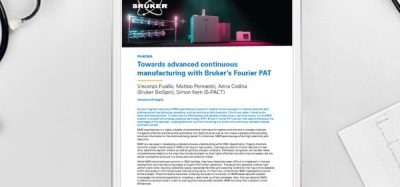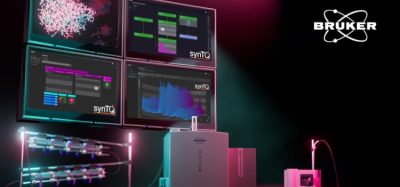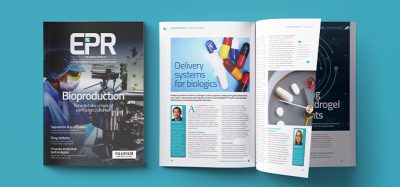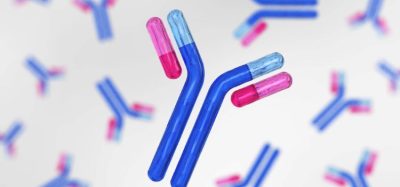PAT for API
Posted: 7 March 2005 |
Pharmaceutical manufacturing occurs in a highly regulated environment, where most of the manufacturing is performed in batches, in stop-and-go steps and with off-line testing of product quality. Additionally, due to patent restrictions, there is always ‘speed to market’ pressure.
Pharmaceutical manufacturing occurs in a highly regulated environment, where most of the manufacturing is performed in batches, in stop-and-go steps and with off-line testing of product quality. Additionally, due to patent restrictions, there is always ‘speed to market’ pressure.
Pharmaceutical manufacturing occurs in a highly regulated environment, where most of the manufacturing is performed in batches, in stop-and-go steps and with off-line testing of product quality. Additionally, due to patent restrictions, there is always ‘speed to market’ pressure.
The pharmaceutical industry uses less automation and process analytical technologies (PAT) than other industries, such as the petrochemical industry1. As a result of the FDA´s PAT initiative, PAT is being promoted in the pharmaceutical industry2. The FDA gave a definition of the PAT initiative in the 2003 draft “Guidance for Industry.”3 This initiative is promoted and supported by several major pharmaceutical companies4,5 and the primary focus seems to be drug product manufacturing6. As an FDA official stated at a post conference workshop7, the PAT initiative is focused primarily on pharmaceutical manufacturing, but also includes active pharmaceutical ingredient/drug substance (API) manufacturing. API manufacturing is a well understood process that has a history with PAT. Process analytical tools have been used for many years to control chemical reactions6. However, the PAT initiative focuses on more than process control. There is a wide area of different topics involved in the FDA´s initiative with different supporters of each sub-area:
- Process control
- Real-time quality control
- Statistical data analysis
- Process understanding
PAT sub-areas
Process control The pharmaceutical industry will only implement PAT tools if the benefits are greater than the costs to implement, validate and support the tools. One significant expense is that any regulatory change must be submitted to all approved countries. Even given this expense, changes to process analytical chemistry are continuously being implemented in the area of process end-point control and control of parameters that are critical in terms of yield and reaction impurities. Process control has been the classical application area for process analytical chemistry in API manufacturing for years, with parameters such as temperature, pressure, pH, moisture, solvent drying, redox probes and spectroscopic techniques such as UV, IR, NIR, Raman, etc.8,9 Utilisation of on-line or in-line rather than off-line process control can result in cost benefits: yields are potentially increased at the right end-point; the batch is produced faster and thus there might be capacity for the next batch sooner. As an example, switching from off-line HPLC to on-line NIR for end-point control maximises yield and minimises reaction impurities that increase at the end of the reaction10.
Therefore, the PAT-area of process control will be endorsed by pilot plant managers for the reduction of cycle times and the improvement of process reliability. For small manufacturing campaigns or discontinuous processes, however, the move away from lab-based testing to online process control is often not feasible. Real-time quality control Today, quality control requires a significant amount of time for sampling, testing (often done manually), evaluating and documenting and is consequently expensive. Often, the production process is interrupted and must wait until the quality of the intermediates has been confirmed by analysis. In the end the majority of samples show results within specification. This is positive for the production process but does not require analytical experts. The implementation of on-line or faster at-line analytics is one possibility to overcome these problems. NIR10-13 and other spectroscopic methods14 are fast and can be used for this purpose. In addition, this equipment can be operated by production staff without analytical training. The increased effort for the calibration of spectroscopic methods (in comparison with classical methods such as HPLC) will be compensated for by the decrease of time for analysis and the possibility of automatisation. Even if the drug substance is released by the use of classical analytical methods, the savings at the intermediate testings could be significant. This will allow analytical experts to focus on the few out-of-specification results (where deeper analysis is necessary) rather than primarily spending time on analysing samples that are in specification. The multitude of in-spec samples can be handled by online techniques as well. This area of on-line analytics will be supported by pilot plant managers as well as quality control managers, because it targets the efficiency of the process and therefore must itself be efficient. Statistical data analysis Statistical process control (e.g. univariate control charts) for the monitoring of changes of critical process parameters within predetermined limits and the calculation of process capability indices (Cpk´s), to judge whether a process is under control, are common practice in the chemical industry15. But often there is an interrelationship between several process parameters for which multivariate data analysis is utilised. Multivariate data analysis is applied in failure investigation and expansion of process knowledge as well. Often an unexpected behaviour of a process can be monitored with already available process parameter data such as temperature, pressure, mass flow rate, agitation speed, etc.16,17 Therefore models for multivariate statistical process monitoring can be developed to detect abnormal situations and to diagnose possible causes for such behaviour. Since individual parameters often cannot predict a quality attribute, soft sensors can be established where many process parameters are modelled to predict the quality18. With chemometric modelled data (process data and quality data) it will be possible to create an ‘index of wellness’ where a slow shifting of a process from the normal process mean could be detected and immediately corrected to improve manufacturing consistency. This will require a switch from an ‘out of specification’ approach to an ‘out of signature’ approach, which will be present in the future and will lead to reduction or elimination of intermediate testing in favour of parametric release. Therefore, special statistical skills will be required in quality control functions. An extensive literature review on this subject has been carried out19. Powerful new methods for the analytical assessment of substances are the evaluation of complete NIR spectra or mass spectra (multivariate output) with chemometric tools. These provide the possibility to assess a substance in total as opposed to classical analytical methods that measure only a specific property. HPLC, for example, only detects substances which elute from the column. This bears the risk of indicating problems (new impurities) that have not been detected with classical analytical methods so far, but this also provides the possibility to improve the process understanding and optimisation. LC/MS or GC/MS analyses result in a three dimensional data matrix: retention time versus mass spectra (m/z) and signal intensity. The extraction of information from such large quantities of data could be enhanced by multivariate methods, such as principal component analysis (PCA) or partial least squares (PLS). There are good examples in literature20,21 of identification of differences in LC/MS and GC/MS data of metabolite samples by PCA and PLS analysis. An evaluation that could also be transferred to the optimisation of the API manufacturing process in terms of impurity profiling. Process understanding Successful validation of the manufacturing process depends on good process knowledge and the identification of critical parameters. The key point in the PAT initiative is process understanding, which starts in the R&D unit of a company. One of the tasks of a chemical development function is to find critical process parameters and to determine acceptable ranges for them in the synthesis of a drug substance. During the development (including the scaleup) of a drug substance synthesis, a lot of information will be collected and reported. The analysis of these historical databases is important toward process understanding and improvement. Synthesis robots, workstations and automated reactors for automated process optimisation with statistical experimental design, as well as multivariate data analysis, are already applied for the purpose of process understanding in development22,23. Additionally, on-line spectroscopy is used as a tool for process monitoring and optimisation24,25.
Modelling in R&D or production
The deriving of a calibration model (chemometric algorithm) for spectroscopic methods (e.g. NIR) consumes both time and money because traditional calibration approaches that utilise primary standards in simple solutions are not applicable in contrast to chromatographic methods (e.g. HPLC). At the beginning of an API synthesis development analytical methods must be very flexible to changes to the process. Since interfering absorption bands due to other components and matrix variations can affect spectroscopic mesurements, chromatographic methods are favoured. The small number of batches produced during development and the continuous changes in synthesis make it impossible to model data for quality control during the development phase of a project. Due to this, classical off-line testing methods (e.g. HPLC) are transferred to the production site instead of model based quality control tests (e.g. NIR). Nevertheless, a Center for Drug Evaluation and Research (CDER) official states that the agency will be receptive to accept PAT in the IND or the drug application and that a good time point to discuss PAT is at the end of Phase II26. When the project is in the production phase, numerous batches are produced that can be used for the modelling of different data to switch from off-line to on-line quality control. In order to assist modelling in the production unit, the development unit could support the production unit with feasibility studies of process analytical tools during the challenge tests and validation phase at the end of the development phase of a project, where data is collected that represents the whole specified area of different parameters.
Perspective
As a consequence of the PAT initiative, parametric release could replace classical product testing. In parametric release the batch is released due to a comprehensive set of in-process tests and controls during the manufacturing process. Requirements such as on-line/inline process control and statistical process monitoring exist. The Active Pharmaceutical Ingredients Committee (APIC) describes the following parameters as typical data of interest for reactions: amounts of chemicals charged; their impurity profile; concentration; pH; temperature; pressure; stirring rate; conversion; contamination control and time15. Furthermore, the approaches to produce drugs or APIs continuously instead of batch wise27,28,1 will probably become increasingly important as it is in other industries, for example the food and detergent industries. In a continuous production process drug substance is manufactured steadily in smaller portions, from raw materials or an intermediate to the API. This is instead of step by step manufacturing (intermediate for intermediate) in a batch oriented mode, where the process is moved on to the next step when the necessary amount is produced in total and the quality of the intermediate is approved. Continuous production could result in smaller factories and more productive processes, in contrast to batch mode. A continuous approach could keep inventory costs of drug substance and intermediates down, increase throughput time and prevent the aging of the substances, since organic compounds are often only stable for a limited time.
Conclusions
The pharmaceutical industry has used process analytical chemistry for years in API manufacturing, primarily for process control and process understanding. Additional implementation of process analytical tools and techniques such as statistical data analysis and real-time quality control will require investments and new skills. All of the discussed PAT areas could help to improve the process reliability, to speed up manufacturing and ultimately to save money. But the modelling and extraction of the huge amount of correlated data collected from different sensors must be performed with great care to assure accurate information within the data. It is important to measure only relevant parameters i.e. parameters that have an influence on the quality of the product. Measuring everything that can be measured inundates the databases with irrelevant data. Due to the small number of batches and the continuous changes in synthesis during development, model-based process analytical technologies (e.g. process signature, NIR) are more likely to be imple- mented after data collection during the routine production phase. It should be stated that not every PAT area is appropriate for every product or every company. FDA officials have stated in talks with the industry that PAT will not be mandatory29. PAT makes good business sense for pharmaceutical companies that produce a large number of batches annually in dedicated facilities or dedicated lines.
Acknowledgement
This article was originally published in American Pharmaceutical Review, September/October 2004.
References
- Abboud, L.; Hensley, S.: Factory Shift – New Prescription For Drug Makers: Update the Plants. The Wall Street Journal 2003 (3rd Sept), 242, 1.
- Cini, P.; Schneider, R.E.: The Push for Modern Manufacturing. Pharmaceutical Executive 2004, 24(3), 86-95.
- U.S. Department of Health and Human Services, Food and Drug Administration, Draft Guidance for Industry: PAT – A Framework for Innovative Pharmaceutical Manufacturing and Quality Assurance, 08/25/2003, http://www.fda.gov/cder/guidance/ 5815dft.pdf.
- The Gold Sheet 2002, 36(2), 1-20.
- Wechsler, J.: Modernizing Pharmaceutical Manufacturing. Pharmaceutical Technology 2002, 26(2), 16-24.
- Blumenstein, J.J.: Meeting the Regulatory Challenges Associated with Process Analytical Technologies. Am. Pharm. Rev. 2003, 6(4), 69-77.
- Afnan, A.: Statement at the Post Conference Workshop on the FDA´s PAT initiative to the European Conference on Near Infrared Spectroscopy in Heidelberg, Germany in Sept. 2003.
- Workman, J.; Koch, M.; Veltkamp, D.J.: Process Analytical Chemistry. Anal. Chem. 2003, 75(12), 2859-2876.
- Küppers, S.; Haider, M.: Process analytical chemistry – future trends in industry. Anal. Bioanal. Chem. 2003, 376, 313-315.
- Stordrange, L.; Malthe-Sørenssen, D.; Høyland, O.M.: Development of a multivariate calibration model of an organic process by near infrared spectroscopy. Journal of Process Analytical Chemistry 2002, 6(1), 6-20.
- Bakeev, K.A.: Near-Infrared Spectroscopy as a Process Analytical Tool. Pharmaceutical Technology Europe 2003, 15(9), 27-32.
- Lyon, R.C.; Jefferson, E.H.; Ellison, C.D.; Buhse, L.F.; Spencer, J.A.; Nasr, M.M.; Hussain, A.S.: Exploring Pharmaceutical Applications of Near-Infrared Technology. Am. Pharm. Rev. 2003, 6 , 62-70.
- Larrechi, M.S.; Callao, M.P.: Strategy for introducing NIR spectroscopy and multivariate calibration techniques in industry. Trends in Analytical Chemistry 2003, 22(10), 634-640.
- Dantan, N.; Küppers, S.: Chemometrie in der industriellen Analytik. Nachrichten aus der Chemie 2001, 49, 917-921
- Active Pharmaceutical Ingredients Committee APIC: Parametric release document, Dezember 2002, http://www.apic.cefic.org/publications/ publications/publications_p.html.
- Hartnett, M.; Lightbody, G.; Irwin, G.W.: Chemometric Techniques in Multivariate Statistical Modelling of Process Plant. Analyst 1996, 121, 749-754.
- Lane, S.; Martin, E.B.; Kooijmans, R.; Morris, A.J.: Performance monitoring of a multi-product semi-batch process. Journal of Process Control 2001, 11, 1-11.
- Lavine, B.; Workman, J.J.Jr.: Chemometrics. Anal. Chem. 2004, 76(12), 3365-3372.
- Kourti, T.: Process Analysis and Abnormal Situation Detection – From Theory to Practice. IEEE Control System Magazine 2002, 22(5), 10-25.
- Idborg, H.; Edlund, P.-O.; Jacobsson, S.P.: Multivariate pproaches for efficient detection of potential metabolites from liquid chromatography/ mass spectrometry data. Rapid Commun. Mass Spectrom. 2004, 18, 944-954.
- Jonsson, P.; Gullberg, J.; Nordström, A.; Kusano, M.; Kowalczyk, M.; Sjöström, M.; Moritz, T.: A Strategy for Identifying Differences in Large Series of Metabolomic Samples Analyzed by GC/MS. Anal. Chem. 2004, 76(6), 1738-1745.
- Weinmann, H.: Laborroboter in kombinatorischer Katalyse und Verfahrensentwicklung. Nachrichten aus der Chemie 2001, 49, 150-154.
- Harre, M.; Tilstam, U.; Weinmann, H.: Breaking the New Bottleneck: Automated Synthesis in Chemical Process Research and Development. Org. Process Res. Dev. 1999, 3(5), 304-318.
- Bjørsvik, H.-R.: Online Spectroscopy and Multivariate Data Analysis as a Combined Tool for Process Monitoring and Reaction Optimization. Org. Process Res. Dev. 2004, 8(3), 495-503.
- Pasquato, L.; Modena, G.; Cotarca, L.; Delogu, P.; Mantovanti, S.: Conversion of Bis(trichloromethyl) Carbonate to Phosgene and Reactivity of triphosgene, Diphosgene, and Phosgene with Methanol. J. Org. Chem. 2000, 65(24), 8224-8228.
- CDER Office of New Drug Chemistry Director Y.Y. Chiu in The Gold Sheet 2003, 37(6), p. 3, paragraph „Learning Before Doing Advocated.”
- Ewers, C.L.J.; Küppers, S.; Weinmann, H.: Pharma supply chain: neue Wege zu einer effizienten Wertschöpfungskette. 2002, Editio- Cantor-Verlag, Aulendorf, ISBN 3-87193-265-5.
- Kussi, J.S.; Leimkühler, H.-J.; Perne, R.: Ganzheitliche Verfahrensentwicklung und –optimierung aus industrieller Sicht. Chemie Ingenieur Technik 2000, 72, 1285-1293.
- The Gold Sheet 2003, 37(6), p. 7, paragraph “Technology Would Not Be Mandatory.”








